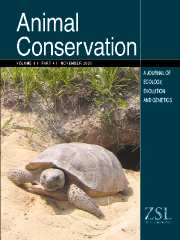Crossref Citations
This article has been cited by the following publications. This list is generated based on data provided by
Crossref.
Schwartz, Michael K.
Tallmon, David A.
and
Luikart, Gordon
1999.
Using genetics to estimate the size of wild populations: many methods, much potential, uncertain utility.
Animal Conservation,
Vol. 2,
Issue. 4,
p.
321.
Ciofi, Claudio
and
Bruford, Mike W.
1999.
Genetic structure and gene flow among Komodo dragon populations inferredby microsatellite loci analysis.
Molecular Ecology,
Vol. 8,
Issue. s1,
Hedrick, Phil W
1999.
Conservation genetics.
Trends in Ecology & Evolution,
Vol. 14,
Issue. 12,
p.
502.
Crandall, Keith A.
Posada, David
and
Vasco, Dan
1999.
Effective population sizes: missing measures and missing concepts.
Animal Conservation,
Vol. 2,
Issue. 4,
p.
317.
Hedrick, Philip W.
2001.
Conservation genetics: where are we now?.
Trends in Ecology & Evolution,
Vol. 16,
Issue. 11,
p.
629.
Julius Skaug, Hans
2001.
Allele-Sharing Methods for Estimation of Population Size.
Biometrics,
Vol. 57,
Issue. 3,
p.
750.
Rieman, B. E.
and
Allendorf, F. W.
2001.
Effective Population Size and Genetic Conservation Criteria for Bull Trout.
North American Journal of Fisheries Management,
Vol. 21,
Issue. 4,
p.
756.
Waits, Lisette P.
Luikart, Gordon
and
Taberlet, Pierre
2001.
Estimating the probability of identity among genotypes in natural populations: cautions and guidelines.
Molecular Ecology,
Vol. 10,
Issue. 1,
p.
249.
Jehle, R.
Arntzen, J. W.
Burke, T.
Krupa, A. P.
and
Hödl, W.
2001.
The annual number of breeding adults and the effective population size of syntopic newts (Triturus cristatus, T. marmoratus).
Molecular Ecology,
Vol. 10,
Issue. 4,
p.
839.
Garrigan, Daniel
Marsh, Paul C.
and
Dowling, Thomas E.
2002.
Long‐term effective population size of three endangered Colorado River fishes.
Animal Conservation,
Vol. 5,
Issue. 2,
p.
95.
Berthier, Pierre
Beaumont, Mark A
Cornuet, Jean-Marie
and
Luikart, Gordon
2002.
Likelihood-Based Estimation of the Effective Population Size Using Temporal Changes in Allele Frequencies: A Genealogical Approach.
Genetics,
Vol. 160,
Issue. 2,
p.
741.
Palomares, F.
Godoy, J. A.
Piriz, A.
O'Brien, S. J.
and
W. E. Johnson
2002.
Faecal genetic analysis to determine the presence and distribution of elusive carnivores: design and feasibility for the Iberian lynx.
Molecular Ecology,
Vol. 11,
Issue. 10,
p.
2171.
Hoy, Marjorie A.
2003.
Insect Molecular Genetics.
p.
400.
Beaumont, M.A.
2003.
Handbook of Statistical Genetics.
Mills, L. Scott
Schwartz, Michael K.
Tallmon, David A.
and
Lair, Kevin P.
2003.
Mammal Community Dynamics.
p.
587.
Pertoldi, Cino
and
Topping, Chris
2004.
Impact Assessment Predicted by Means of Genetic Agent-Based Modeling.
Critical Reviews in Toxicology,
Vol. 34,
Issue. 6,
p.
487.
Tallmon, David A
Luikart, Gordon
and
Beaumont, Mark A
2004.
Comparative Evaluation of a New Effective Population Size Estimator Based on Approximate Bayesian Computation.
Genetics,
Vol. 167,
Issue. 2,
p.
977.
Lorenzini, Rita
Posillico, Mario
Lovari, Sandro
and
Petrella, Annino
2004.
Non‐invasive genotyping of the endangered Apennine brown bear: a case study not to let one's hair down.
Animal Conservation,
Vol. 7,
Issue. 2,
p.
199.
Matocq, M. D.
2004.
Reproductive success and effective population size in woodrats (Neotoma macrotis).
Molecular Ecology,
Vol. 13,
Issue. 6,
p.
1635.
JOHNSON, JEFF A.
BELLINGER, M. RENEE
TOEPFER, JOHN E.
and
DUNN, PETER
2004.
Temporal changes in allele frequencies and low effective population size in greater prairie‐chickens.
Molecular Ecology,
Vol. 13,
Issue. 9,
p.
2617.


